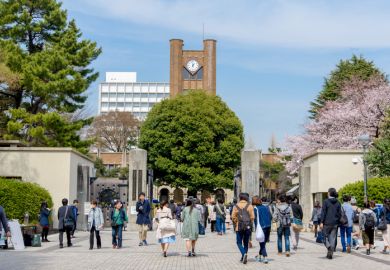China and Japan, the two largest receiving nations for foreign students in Asia, also have some of the world’s strictest border controls for readmitting foreign students and academics, some of whom remain shut out after half a year.
China’s borders closed in March and have not fully opened since. At the peak of its epidemic, there was only one weekly flight from each foreign country, causing a spike in ticket prices that left even some Chinese nationals unable to get home. While regulations have eased for Chinese citizens and select work visa holders, there is still not a free flow of traffic into China.
Japan has come under criticism from the higher education community for regulations that have barred some non-Japanese citizens from returning to their schools and academic workplaces.
Both countries have seen increases in foreign students in the past few years, particularly from other Asian nations. There were nearly 500,000 foreign students in China in 2018, according to the education ministry, and more than 300,000 in Japan, according to the Japan Student Services Organization.
Michael Vyshnepolsky was intending to attend a language school in Japan in April, after completing a PhD in chemistry in Germany, and then finding work there. He had completed applications, paid fees, submitted paperwork to the embassy and expected a visa in a week, which has not come through.
“In these six months, I received zero information on when Japan plans to reopen borders,” he told Times Higher Education. “I have had no income for five months now. Planning has been impossible since no information is provided. Therefore the whole situation has become mentally and financially very frustrating for me.”
There is a similar situation in China. Sixth Tone, a Chinese news website, interviewed foreign students stuck everywhere from Bulgaria to Sudan, Pakistan and Thailand. They were struggling to finish thesis dissertations and laboratory work remotely for Chinese universities, and in some cases dropped out.
Some academics have also been caught in the net. Areum Jeong, an assistant professor at the Sichuan University-Pittsburgh Institute, told THE that she taught remotely from her native South Korea from January to August. At the time of writing, she was back in China, but under quarantine.
“I feel privileged that I was able to go through the process safely,” she said. “I realise it isn’t easy, especially for precarious academics. Probably one of the toughest things was the uncertainty.”
Other places in the region, such as South Korea, Singapore, Hong Kong and Taiwan, have been more open to foreign students, although many loosened restrictions only recently and still have strict quarantines.
The protectionist reaction in Asia has been markedly different than in the West, where major receiving nations such as the UK and Canada are actively working to recruit or retain foreign students, who are a major source of income for universities.
Yang Rui, associate dean (research) at the University of Hong Kong’s Faculty of Education told THE that a combination of factors led to the different responses.
“A major reason is financial,” he said. “Many Western universities have been selling education for a long time, and this has become their normal operation…In contrast, neither Japanese nor Chinese universities have treated education as a business. They treat it more as ‘soft power’ and are thus willing to spend money on it. Other Asian universities are in a similar situation.”
Foreign students make up less than 2 per cent of college and university students in China, and less than 8 per cent in Japan. However, their absence is still felt.
Rochelle Kopp, who teaches at the University of Kitakyushu, told THE that, “with the number of college-aged Japanese falling, these international students are an increasingly important revenue source for Japanese universities”.
Register to continue
Why register?
- Registration is free and only takes a moment
- Once registered, you can read 3 articles a month
- Sign up for our newsletter
Subscribe
Or subscribe for unlimited access to:
- Unlimited access to news, views, insights & reviews
- Digital editions
- Digital access to THE’s university and college rankings analysis
Already registered or a current subscriber?










